From Sarajevo to Mostar: An Unforgettable Journey in Bosnia and Herzegovina
- berfinozelsel

- Dec 27, 2024
- 16 min read
Updated: Oct 13
BOSNIA AND HERZEGOVINA TRAVEL GUIDE
A country where you will not feel like a stranger when you go among the visa-free Balkan countries, where you will discover every street with its tragic history and where you will be amazed by its lush nature despite the long wars. Our next stop after Montenegro on our Balkan Tour by car was Bosnia and Herzegovina. There are 2 cities that I would recommend you to visit in Bosnia; the first is of course the capital Sarajevo; also known as Sarajevo, and the second is Mostar, which will be remembered with its greenery and bridge.
In this guide, we will share with you the beauties of Bosnia and Herzegovina waiting to be discovered.
TRAVEL GUIDE: BOSNIA-HERZEGOVINA

History
Bosnia and Herzegovina is located in Southeastern Europe and its capital is Sarajevo.
Bosnians, Serbs, Croats and other ethnic groups live together in the country. As a reflection of this cultural diversity, the country has three official languages: Bosnian, Croatian and Serbian.
The currency of Bosnia and Herzegovina is the Bosnian-Herzegovinian Mark, commonly known as the Convertible Mark (KM).
Bosnia and Herzegovina is a country located in the southeast of Europe, on the Balkan Peninsula, and is rich in history and culture. Its geographical location has made it a crossroads for various civilizations throughout history, which has contributed to the country's unique identity. After the division of the Roman Empire, Bosnia and Herzegovina came under the rule of the Byzantine Empire and existed as an independent kingdom in the 12th century.
Conquered by the Ottoman Empire in 1463, Bosnia and Herzegovina came under Ottoman rule. This period was a significant turning point in the country's history. The spread of Islam, the construction of magnificent architectural structures and the formation of a multicultural society took place during this period. Bosnia became one of the Ottoman strategic provinces in the Balkans. However, with the decline of the Ottoman power in the 19th century, Bosnia and Herzegovina was left under the control of the Austro-Hungarian Empire by the decision of the Berlin Congress of 1878.
At the beginning of the 20th century, Bosnia and Herzegovina witnessed an important event that affected world history. The assassination of Austrian Archduke Franz Ferdinand in Sarajevo by a Serbian nationalist in 1914 led to the start of World War I. After the war, Bosnia and Herzegovina became part of the Kingdom of Yugoslavia. After World War II, it was incorporated into the Socialist Federal Republic of Yugoslavia. However, with the dissolution of Yugoslavia, Bosnia and Herzegovina declared its independence in 1992, and the Bosnian War began immediately after the declaration of independence. This war, which lasted from 1992 to 1995, witnessed deep ethnic conflicts between Bosnians, Serbs and Croats and went down in history as a dark mark. The Srebrenica Genocide took place during the war. The war ended with the Dayton Agreement signed in 1995, and Bosnia and Herzegovina was rebuilt with a complex administrative system.
To understand the complex structure of Bosnia-Herzegovina today, it is necessary to return to the founding process of Yugoslavia. The Federal Republic of Yugoslavia, founded in 1943 under the leadership of Tito, pursued an independent foreign policy during the Cold War as a state that included different religious and ethnic communities. However, after Tito's death in 1980, the balance in the federal system was disrupted and nationalist movements began to rise rapidly.
With the collapse of the Soviet Union in the 1990s, the ethnic communities that formed Yugoslavia sought independence. Slovenia and Croatia were the first countries to declare their independence. A referendum in Bosnia-Herzegovina also resulted in independence, but this result was not accepted by the Serbs. The civil war that began in 1992 continued until it ended with the Dayton Agreement signed in 1995. During the war, civilians in Bosnia-Herzegovina were heavily targeted and massacres were carried out by Serb forces. Although the United Nations declared Srebrenica a “safe zone” in 1993, this decision was not effective enough and the city was besieged by the Serbian army. The Bosnians, who were restricted by an arms embargo throughout the war, had to resist the heavy weapons of the Serb forces under difficult conditions. The Serbian army, under the command of Ratko Mladic, known as the “Butcher of Bosnia,” carried out one of the most horrific genocides in history before the eyes of the entire world. Bosniak civilians were tortured for days and detained in concentration camps, brutally murdered in front of their families and loved ones. At least eight thousand Bosniak Muslims, mostly men and children, were killed in Srebrenica. The exact number is still unknown.
Bosnians applied to the International Court of Justice long before the Srebrenica Massacre to have war crimes in Bosnia tried. However, the court only made calls to prevent genocide and did not impose any sanctions. Following a new application made in 2003, on February 26, 2007, the Court accepted the events in Srebrenica as genocide, but Serbia was not directly accused due to lack of evidence. Although this decision did not fully meet the expectations of the Bosnian people for justice, it did ensure that the genocide was recognized internationally. Following this, a commission of inquiry was established to find the mass graves.
During this period, a plant species began to spread, especially in Srebrenica and its surroundings. This plant, called Artemisia Vulgaris, is known among the public as the "Flower of Death" and commonly as 'Lavinia' and usually grows in cemeteries. The mineral richness in these blood-soaked lands caused the number of these plants to increase.
In areas where the Artemisia plant is densely populated, a significant increase in the number of blue butterflies that feed solely on this plant has been observed. This ecological change has attracted the attention of scientists, and excavations have begun in the region. Initially, individual graves were unearthed, but as excavations deepened, mass graves were discovered. Locals have also joined the process, contributing to uncovering the traces of the brutality.
The 1995 Dayton Peace Agreement ended the Bosnian War and established the country's current political system. Bosnia and Herzegovina has a federal state structure consisting of two main entities (regional administrations) and one autonomous region.
The administrative system of Bosnia and Herzegovina operates on a federal basis and the state is organized to represent three ethnic groups (Bosniaks, Serbs, Croats). The country's administrative system seems quite different to us, for a better understanding; The country is divided into two main entities:
Federation of Bosnia and Herzegovina (Federacija Bosne i Hercegovine) : Consists of regions where the majority of the population is Bosniaks and Croats.
Republika Srpska : The region where the majority of the population is Serb.
Additionally, the Brčko District , located in the north-east of the country, has an autonomous status that is not part of either entity. The Brčko District gained this special status through an international arbitration decision within the scope of the Dayton Agreement.
The governance structure of Bosnia and Herzegovina reflects the deep divisions created by the past war. There are still significant political divisions between ethnic groups in the country, and you will feel this as you tour the city. However, with the support of the international community, Bosnia and Herzegovina is striving to achieve economic and political stability. It is trying to progress in its integration with the European Union and is continuing its membership application process.
This complex federal structure, while intended to maintain peace in the country, frequently leads to administrative deadlock and political disagreements.
PLACES TO VISIT
We started our Bosnia-Herzegovina trip from Mostar as per our route, because Mostar is closer when you set off from Montenegro, after completing our Mostar trip we visited the capital of the country, Sarajevo. First we will talk about the places to visit in the capital Sarajevo and then the places to see in Mostar.
We spent one day for Mostar and one full day for Sarajevo, and in total we were able to visit the important places in this country in 2 days.
You should start your Sarajevo trip from the Main Bazaar, which is the city center and the meeting point of the people, where Sebil is located. The places you can see on the first day are; (if you don't want to read the whole article, tell us the places to visit in short :) here you go ↓)
You can visit the Fountain, National Library, Gazi Hğsrev Bey Mosque (Begova Dzamija), Kazancılar Street, Bursa Bezistan, Taşlıhan, Sarı Bezistan, Svrzo House, Clock Tower, Catholic Cathedral, Morica Han , Ferhadiye Street, Eternal Flame Monument, Latin Bridge, Sultan Mosque, İnat Kuca House, At Meydan Park, Sacred Heart of Jesus Cathedral and Serbian Orthodox Cathedral . You should spend your second day to the Tunnel of Hope (can be visited with info bosnia tour), Kovaci Martyrdom (Kovaci Groblje), Vrelo Bosne Park.
If you need a shopping mall You can visit Sarajevo City Centre (SCC).
Main Bazaar
A bazaar with various shops and restaurants in the city center. Among the places you should see in the main bazaar is the Sebil, which was first built during the Ottoman period.
You will find antique shops and souvenir shops in the streets around the fountain.
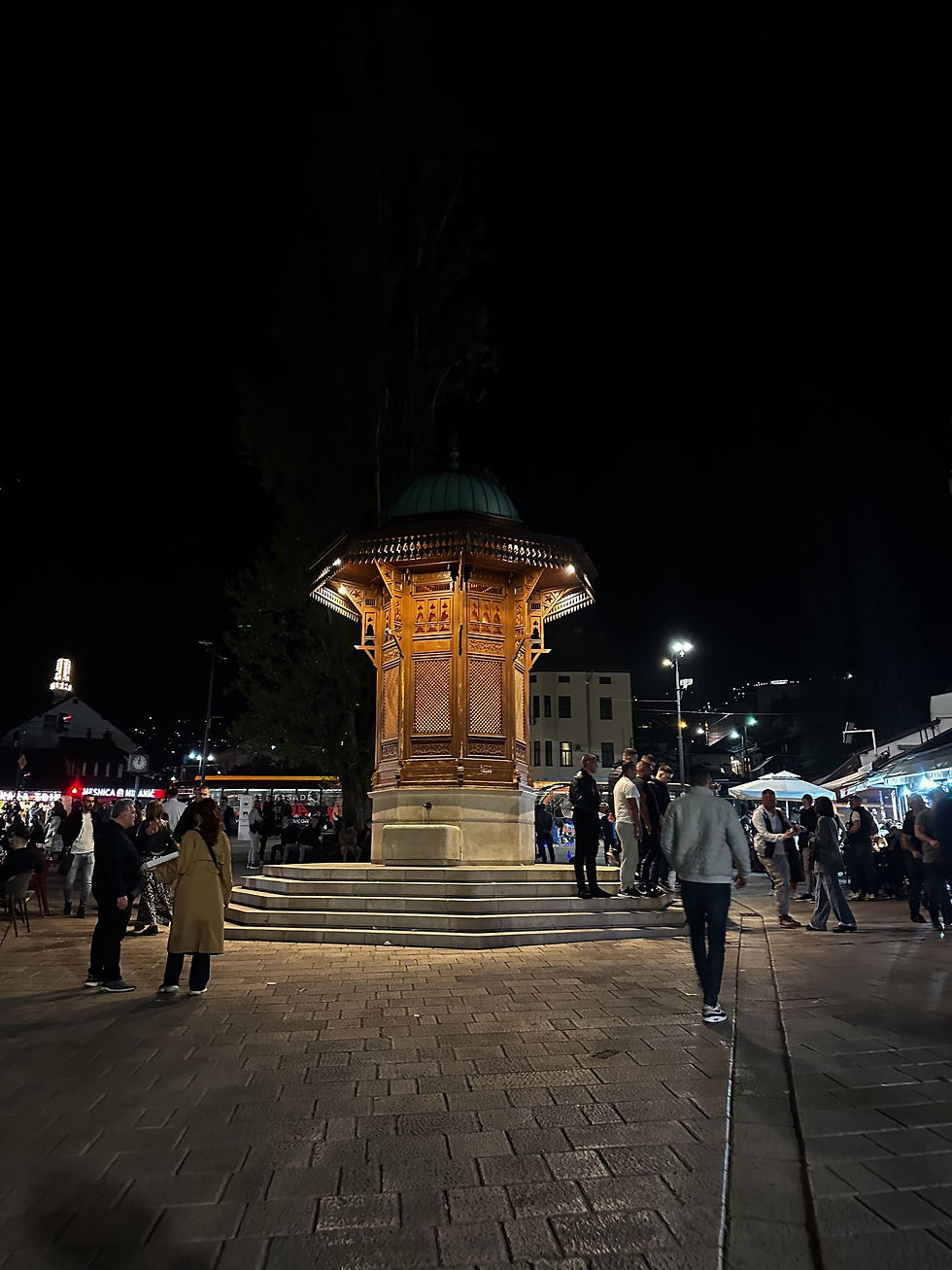
Cathedral of the Sacred Heart of Jesus
The largest Catholic church in Sarajevo is the Cathedral of the Sacred Heart of Jesus, located on Bascarsija Road, with a statue of Pope John Paul II in front of it.
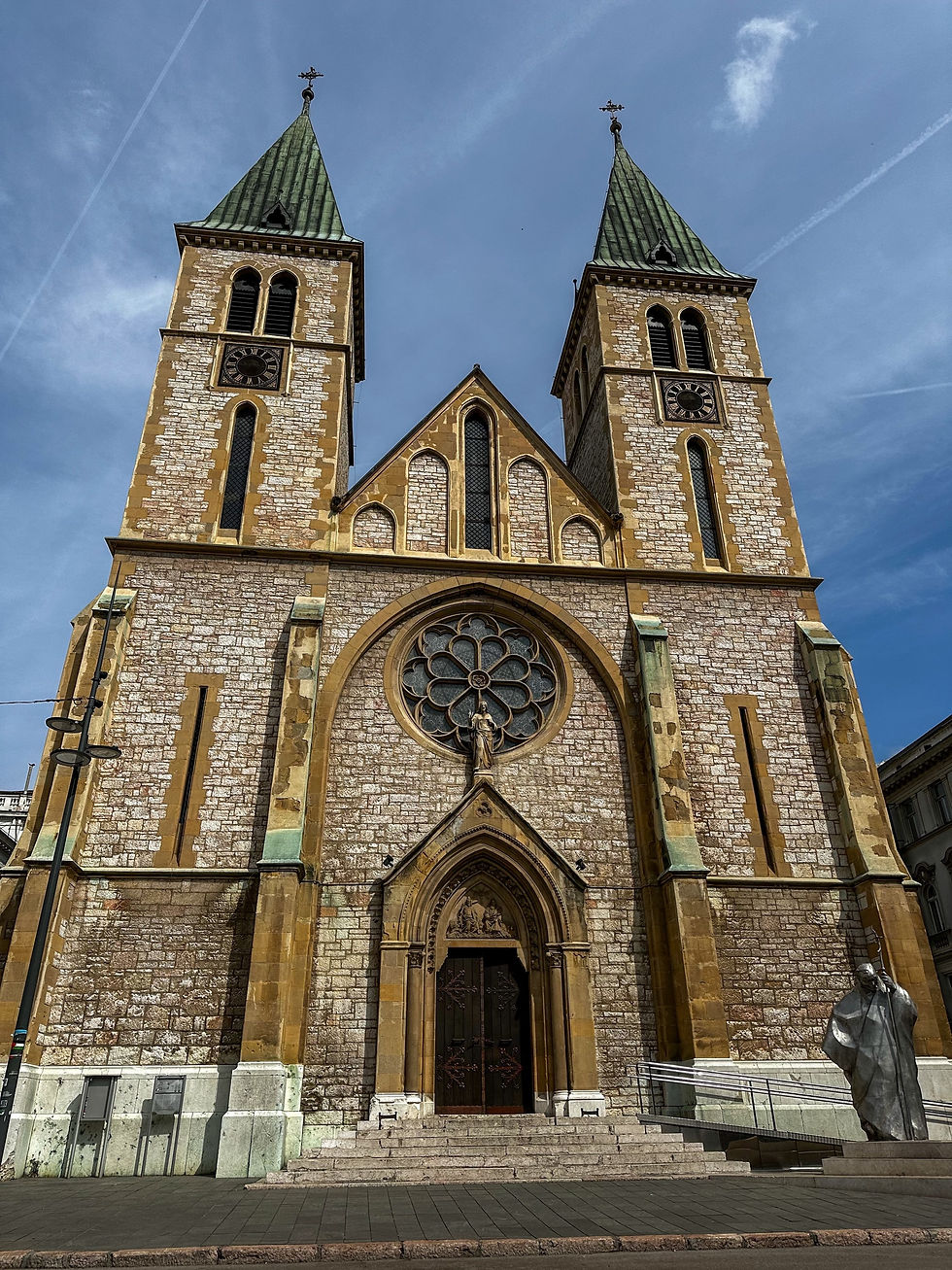
LATIN BRIDGE
Latin Bridge (Latinska Ćuprija) is an Ottoman-era bridge over the Miljacka River in Sarajevo that has witnessed important events in Bosnia's history. The bridge is also known as the site of the assassination of Archduke Franz Ferdinand of Austria and his wife Sophie by a Serbian nationalist on 28 June 1914. This event was a historical turning point that led to the start of World War I. Today, the Latin Bridge is one of the symbols of Sarajevo, both for its historical and touristic significance.

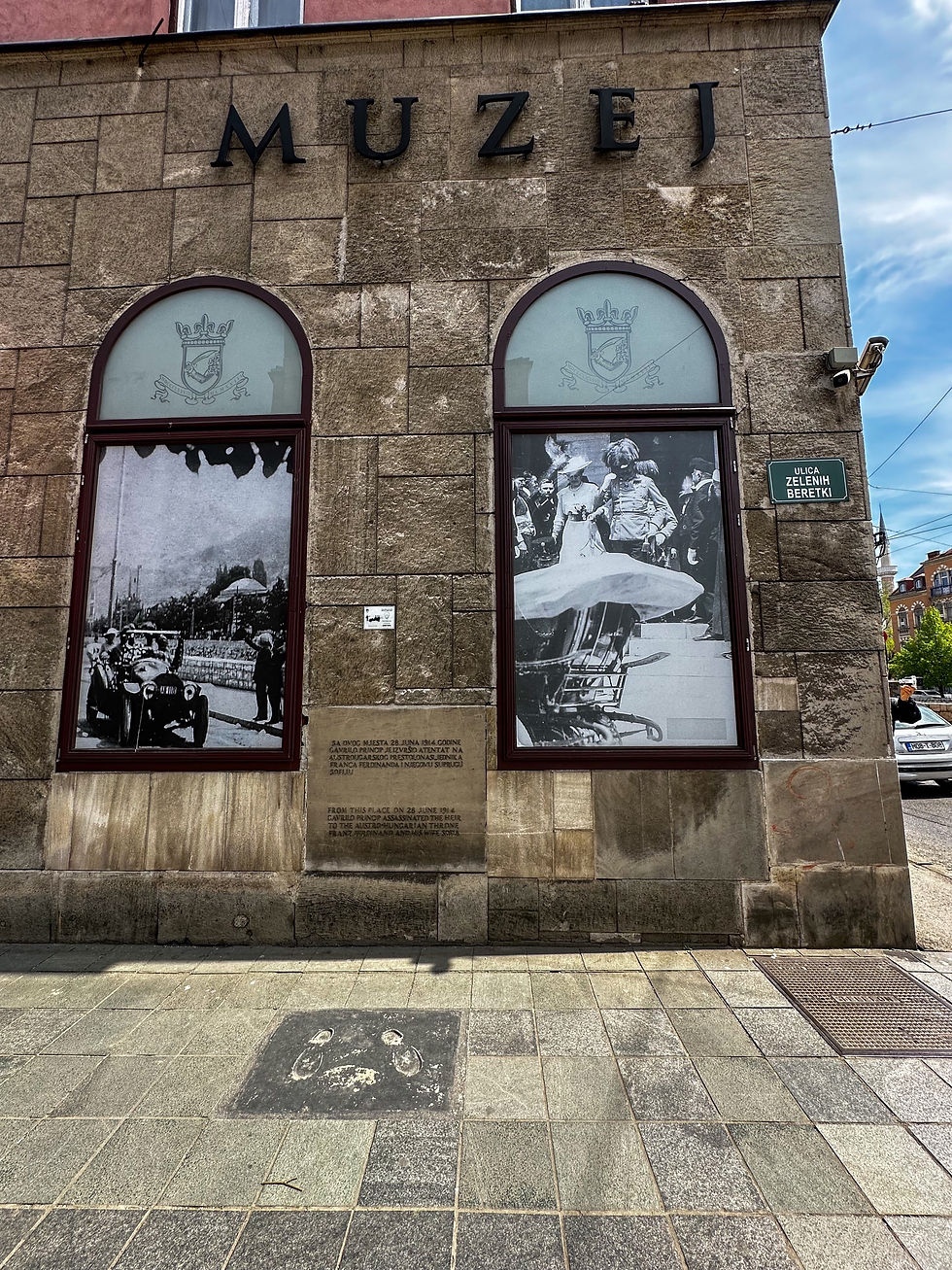
ETERNAL FIRE MONUMENT
The monument, located at the intersection of Ferhat Pasha Street and Marshal Tito Street, was built to commemorate the victims of World War II. Its ever-burning fire and the Bosnian inscription on its arch symbolize the heroism of the Sarajevans and the gratitude felt for the martyrs. Although the fire was only extinguished during the siege of Sarajevo, the liveliness of the surrounding street gives the monument a special spirit.
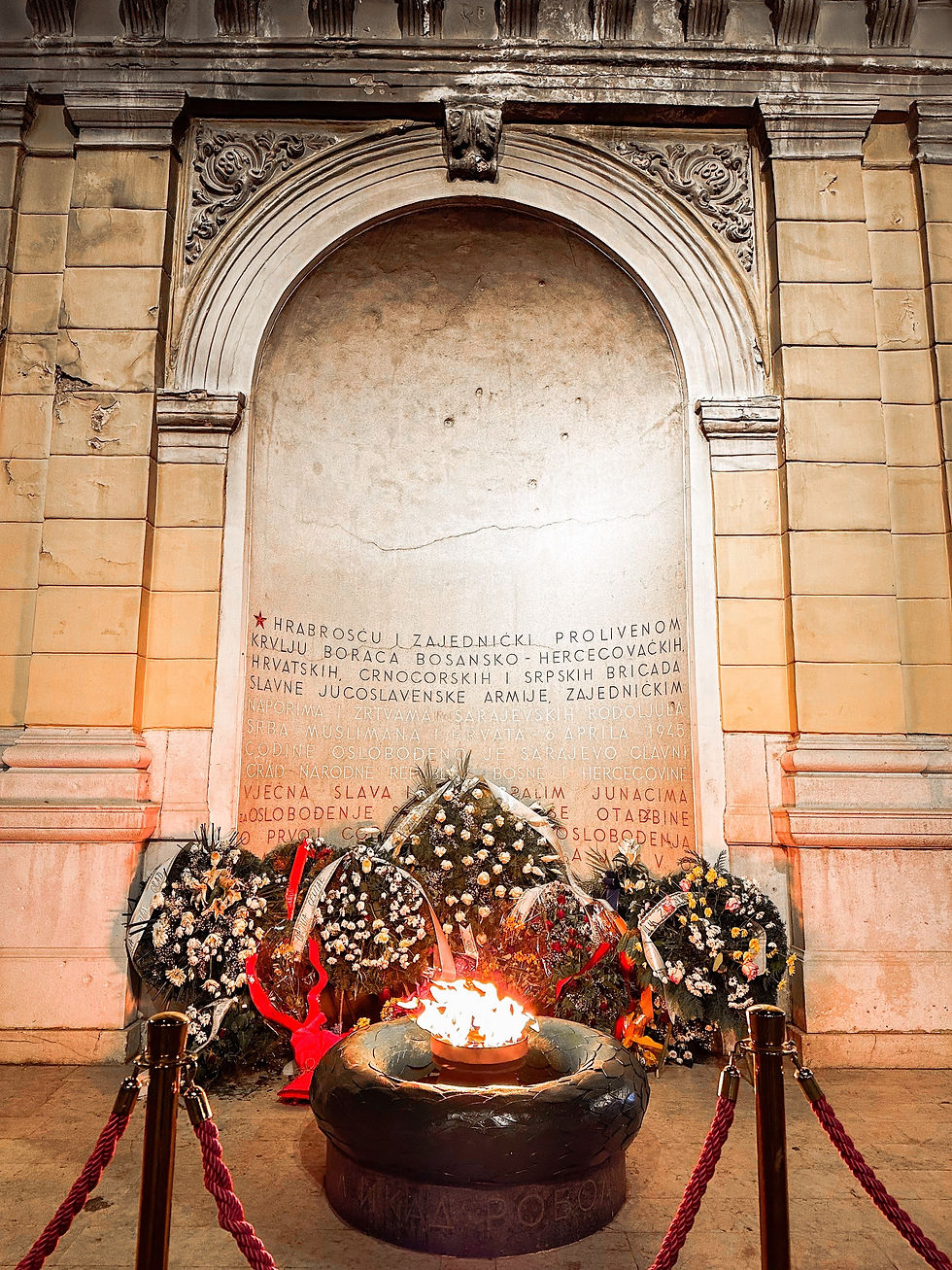
Gazi Husrev-bey Mosque (Gazi Husrev-begova džamija)
Gazi Husrev Bey left an important cultural heritage to the city with the social complex, library and other works he had built in Sarajevo. Built in 1531, Gazi Husrev Bey Mosque (Bey Mosque) belongs to Mimar Sinan and is one of the most striking examples of Ottoman architecture in the city.
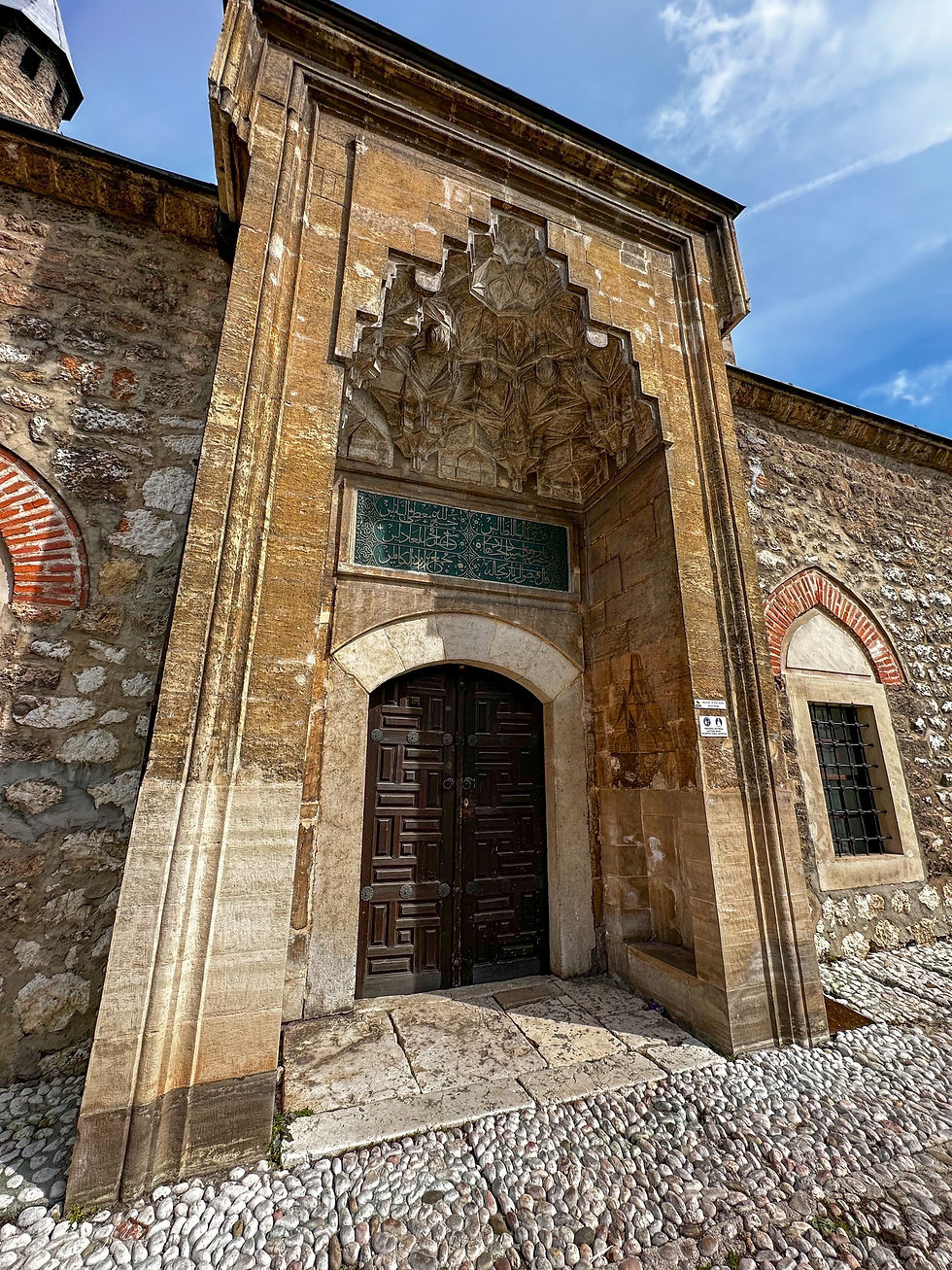
MORICA HAN
Morica Han is an Ottoman caravanserai located on Saraci Street in Bascarsija. Rebuilt in the 17th century after a fire, the han is surrounded by rooms and shops around an open courtyard. This historic venue, where merchants once stayed for three nights, is today an ideal stop for a coffee break and to discover Bosnian textiles. Closed on Sundays.
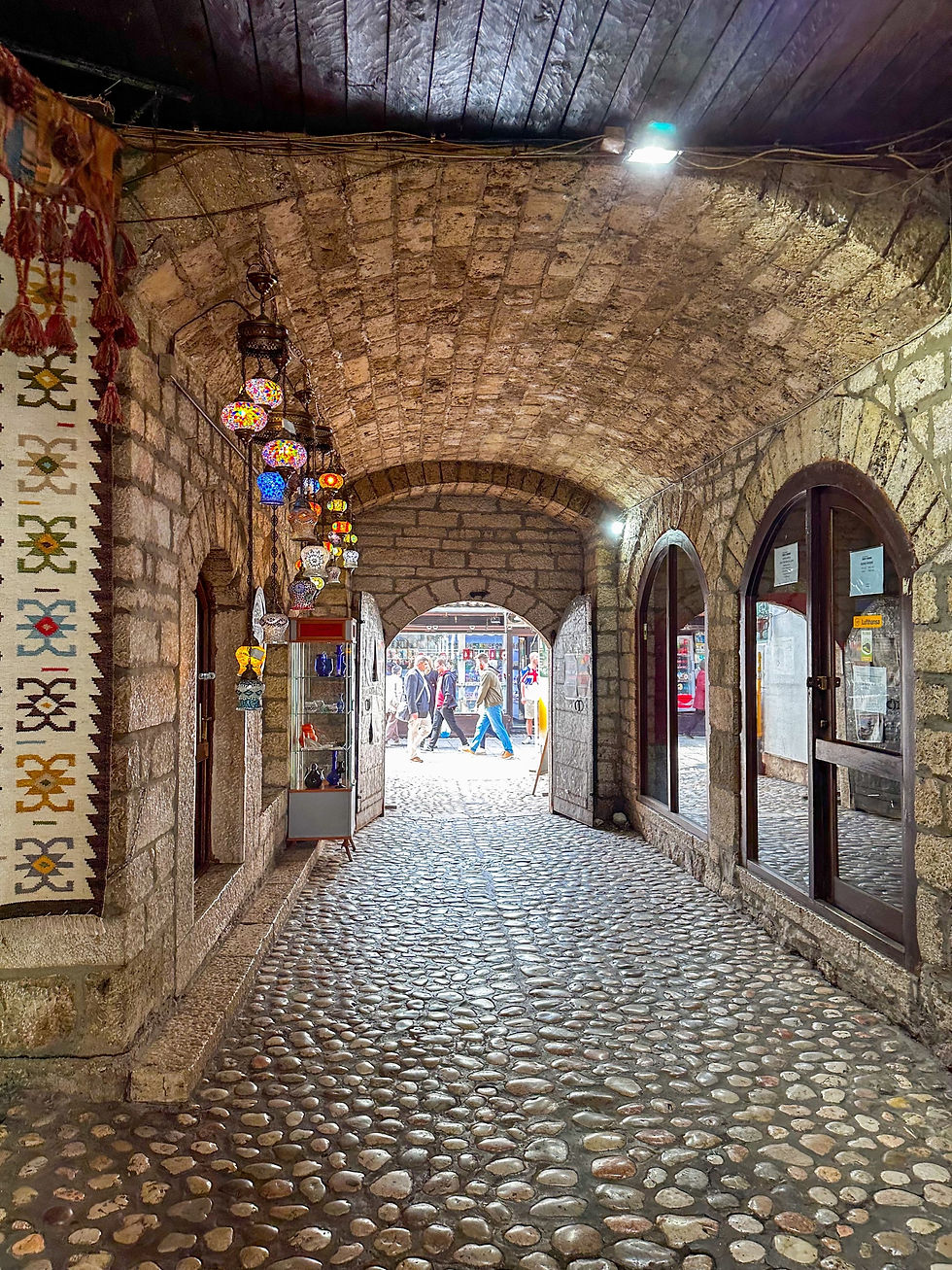
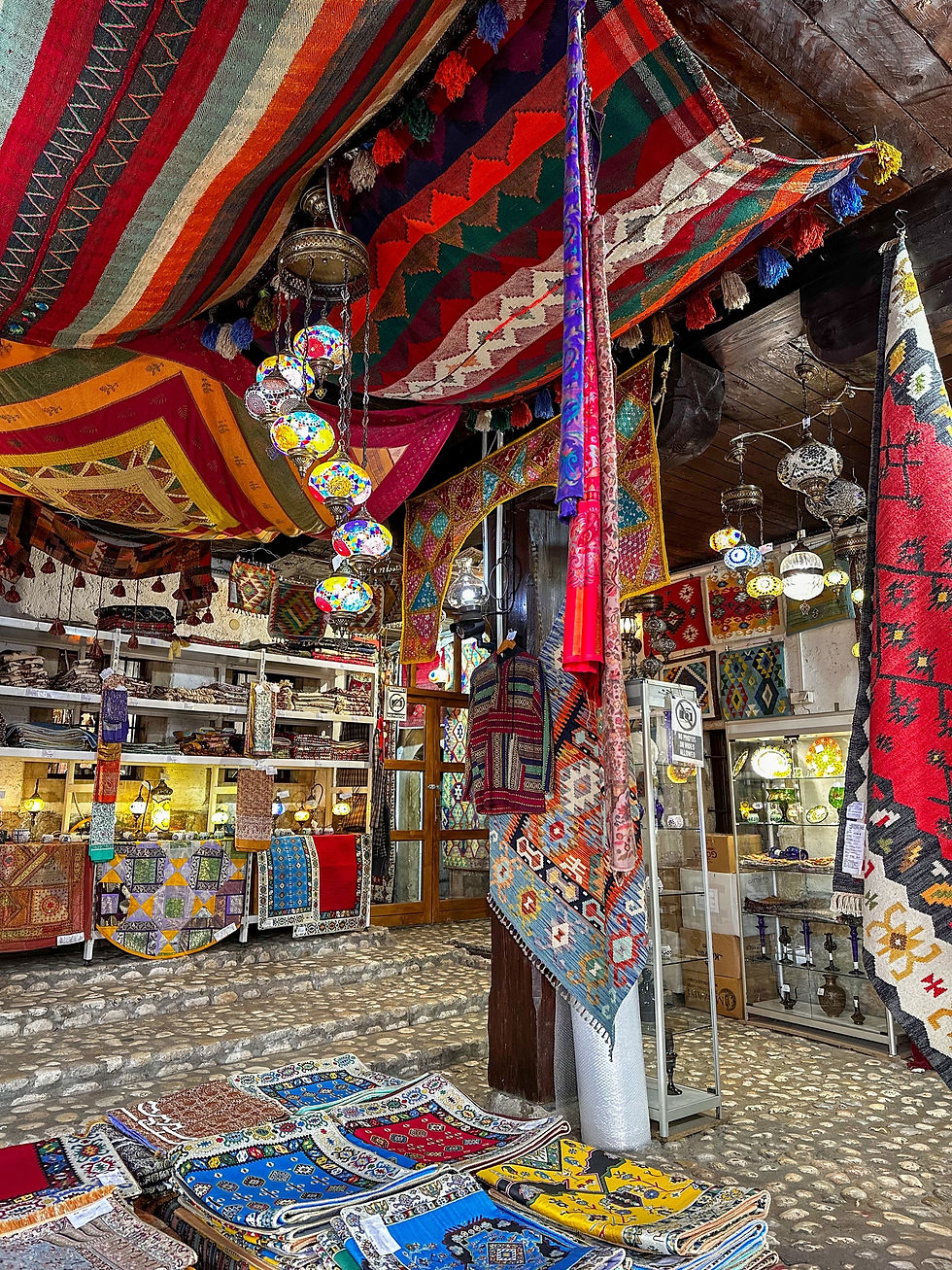
Serbian Orthodox Cathedral
Built in the 19th century, the Cathedral of the Nativity of the Virgin Mary is an onion-domed basilica. Although it looks closed, you can pay a fee to enter and explore the five-domed structure and its icons.
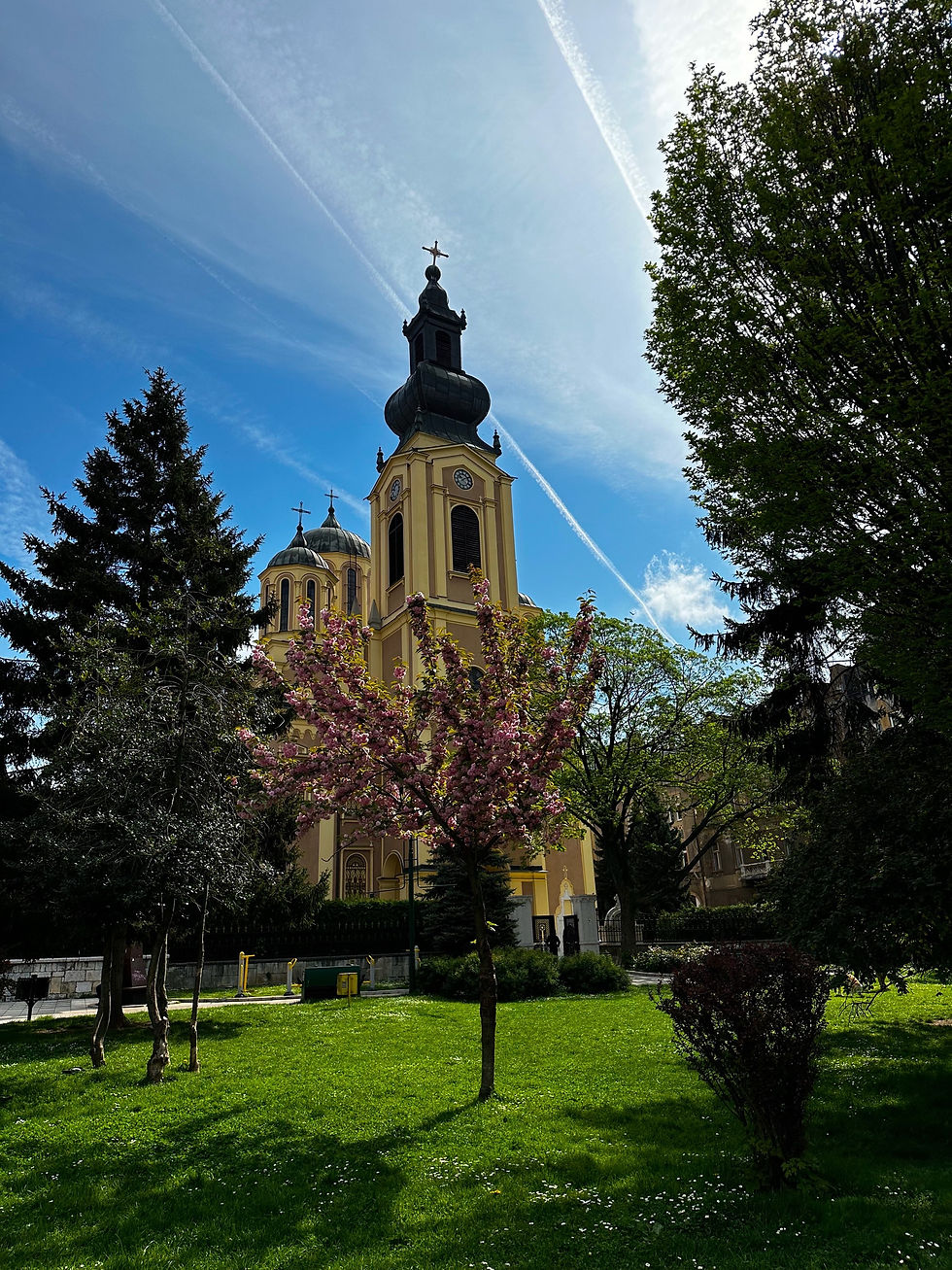
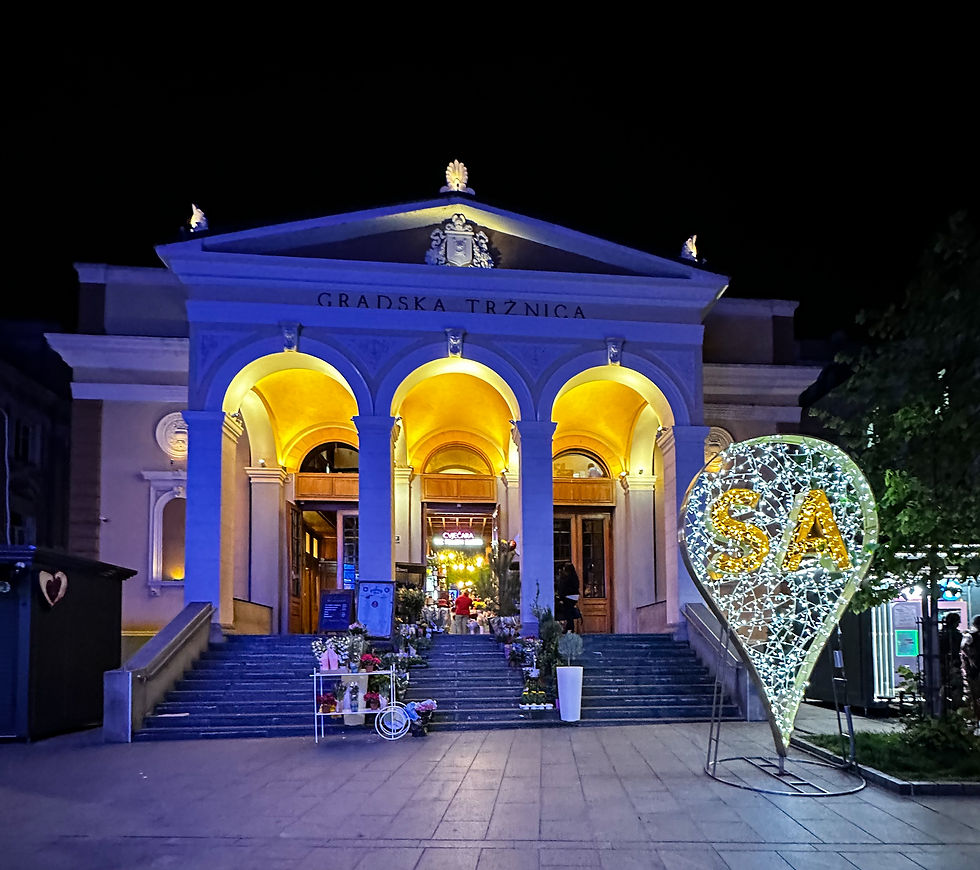
Ferhat Pasha Street / Ferhadija
It is the most famous street in Sarajevo. It resembles Istiklal Street with its restaurants, cafes, mosques, churches and stores. The most interesting point of the street is the point where you can clearly feel the architectural difference from the Ottoman to the Austro-Hungarian Empire. As if a line is drawn in the middle of the street, the right side is separated by Ottoman architecture and the left side by Hungarian architecture. You should definitely see this point. If you want to go shopping, keep in mind that most stores are closed after 19:00 in the evening and on Sundays.
Tunnel of Hope
During the Bosnian War, Sarajevo was under siege for approximately 3.5 years and when Sarajevo was completely cut off from the outside world, a tunnel approximately 800 meters long was dug in 1993 to transport food, medicine and military equipment and to evacuate the population. The tunnel was built under the leadership of Alija Izetbegović and his friends to provide access to the airport under United Nations control. The tunnel connects Sarajevo to the safe zone so that they can access the supplies sent for aid.
It is quite difficult to pass through as it is only 1 meter wide and 160 cm high. However, it is known that about 1000 people moved through this tunnel every day during the war years.
This tunnel starts under the house belonging to the Kolar family, today the Kolar family house and a part of the tunnel have been converted into a museum. This museum offers visitors an impressive experience to understand the harsh conditions of the war and the resistance efforts of the Bosnian people. It is recommended that those who want to see the traces of the war closely visit this sad but historical place. You can visit the tunnel with a guide, you will feel the pain and difficulties experienced at that time, even if only a little.
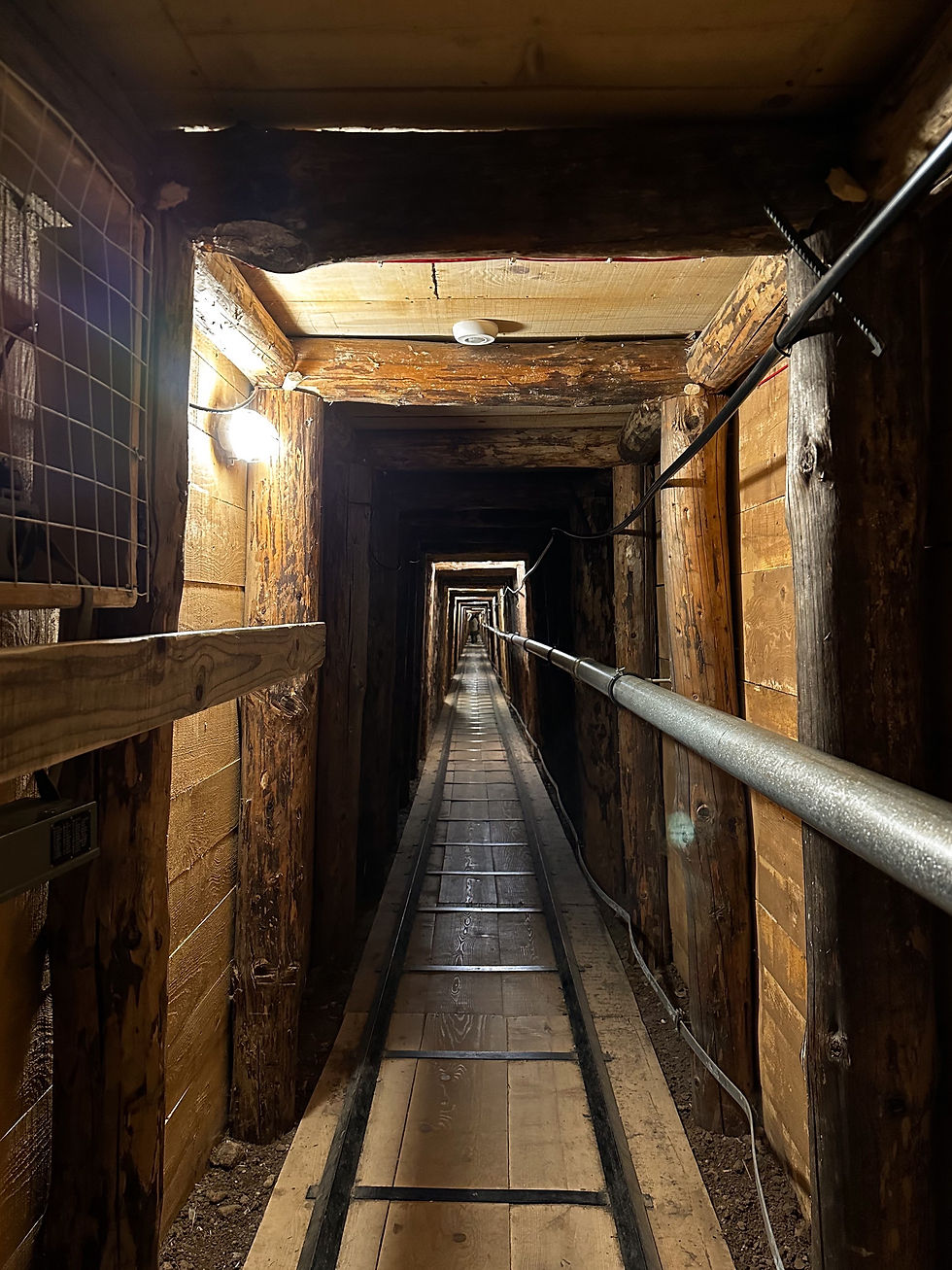
Ilıca (Ilidža) – Vrelo Bosne
Located in the Ilica district of Sarajevo, about 10 km from Bascarsija, Vrelo Bosne is one of the city's most peaceful parks, hosting the source of the Bosna River. You can reach here by car, tram and taxi.
The park offers a great place to walk, cycle or ride a horse-drawn carriage along the tree-lined Velika Aleja road. You can relax with a Bosnian coffee while enjoying nature. Please note that there is a fee to enter the park and you will need to have cash KM with you. Also, the proximity of the park to the Tunnel of Hope makes it easy to visit both places on the same day.

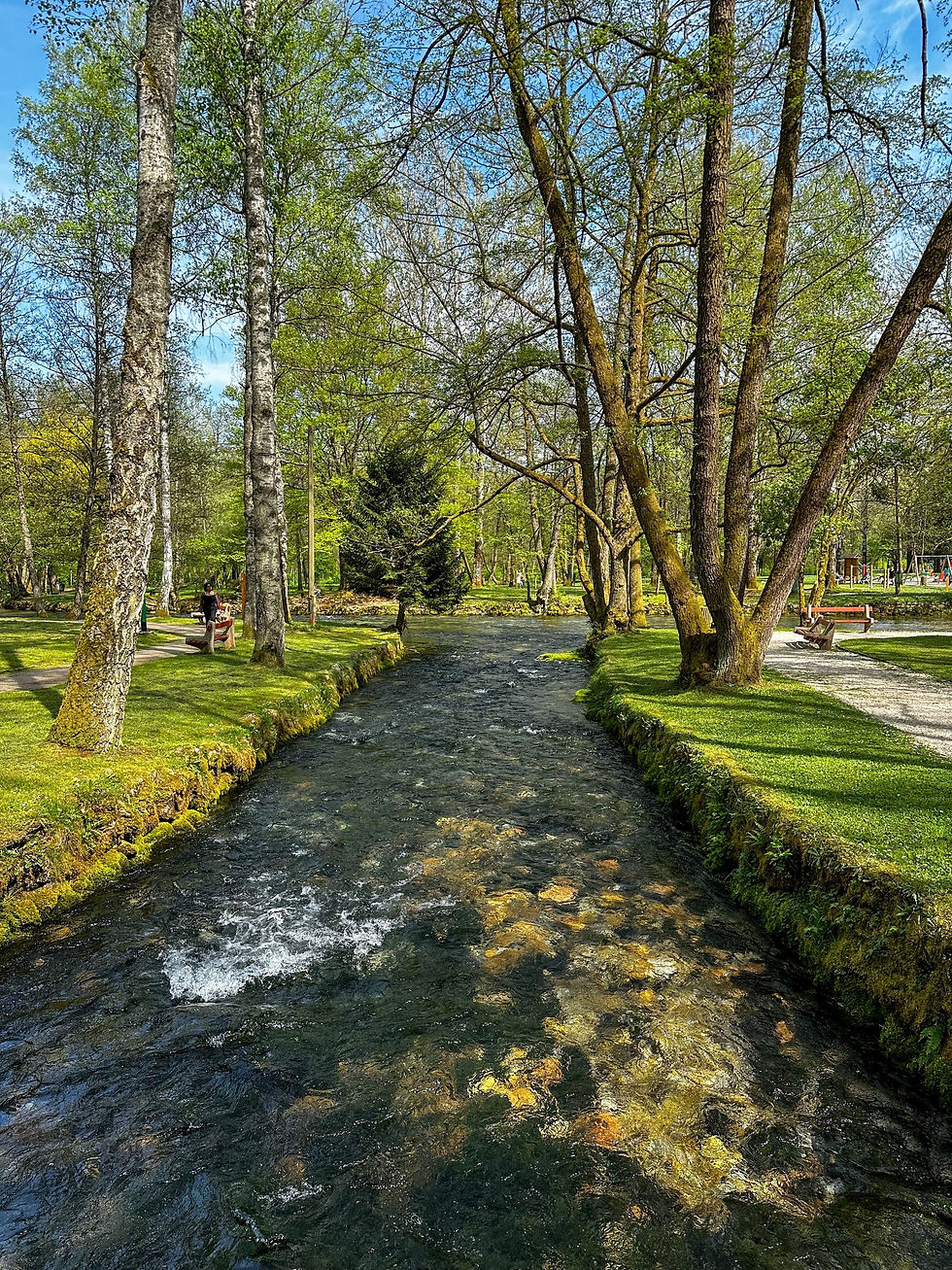
Kovaci Martyrdom (Kovaci Groblje)
Kovaci Martyrdom is known as the cemetery of the martyrs of the siege of Sarajevo and has a cemetery from the Ottoman period on one side. The monumental tomb of Alija Izetbegovic is also located here. In the upper part of the cemetery there is a museum dedicated to Alija Izetbegovic.
When you continue climbing from this cemetery to the top, you will first come across the Yellow Bastion, where you can watch the view of Sarajevo at sunset. From here, you can watch the panoramic view of the city from the White Bastion, which is even higher, but if you do not have time, we do not think you should prioritize these points.
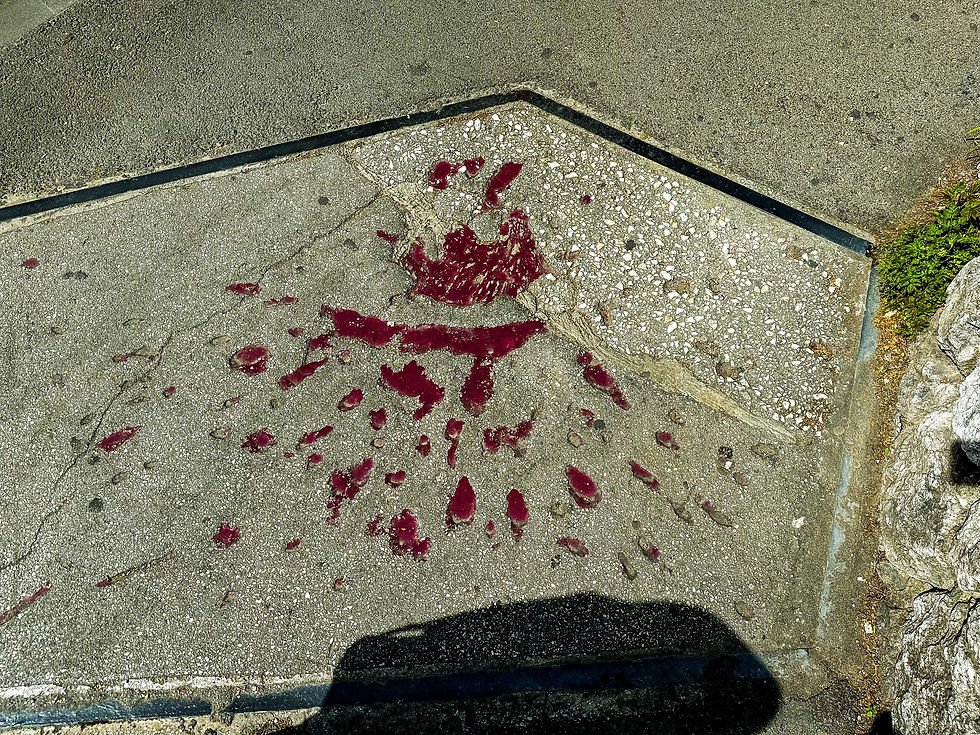
''Sarajevo Roses'' is the name given by the people to these spots that resemble scattered rose petals. The bombs dropped during the civil war in Bosnia-Herzegovina left permanent marks in every corner of the country. These red spots seen on the streets of Sarajevo, resembling flowers, are the traces left by the bombs filled with red resin. The people of the city preferred not to erase these marks in order to keep the painful memories of the war alive and not to forget.
Additionally, while touring the city, you will see old, ruined buildings with traces of bombs and bullets, and the people of the city do not want these buildings to be restored so that what happened is not forgotten.
MOSTAR
Mostar is one of the most touristic spots in Bosnia-Herzegovina, with its streets blending Ottoman and Croatian architecture and its lush green mountains. After coming under Ottoman rule in 1468, the city developed rapidly, and Christians and Muslims began to live together. You can visit Mostar in a few hours, and the nearby Kravitse Waterfalls can also be added to this route.
The distance between Sarajevo and Mostar is 125 km and the journey takes about two and a half hours. You can reach Mostar from Sarajevo by buses or trains departing from Zeljenica Stanica Station.
If you went with your car or rented a car, you should definitely experience the road between Mostar and Sarajevo, you will pass through lush green roads that you will admire. Similarly, when you travel by train, it is said that you pass through very beautiful roads, we could not experience it, but I recommend it.
The Old Town section of Mostar, dating back to the Ottoman period, still maintains its bazaar character. Spending time in these nostalgic streets is as enjoyable as Sarajevo’s Main Bazaar. You can also buy various local souvenirs here. The Crooked Bridge, Spanish Square, Muslim Bey Mansion, and Biscevica House are other Ottoman structures you can visit in the city. Karagoz Bey Mosque is also an Ottoman structure built by Mimar Sinan.
If you have time after visiting Mostar, you can create a route like Mostar-Blagaj (Alperenler lodge)-Pocitel. You can also visit Konjic town which is 1 hour away from here.
Mostar Bridge (Stari Most)
The symbol of Mostar, the Stari Most (Old Bridge) is an important structure that connects the two banks of the Neretva River and is on the UNESCO World Heritage List. Built in 1566 by Mimarbaşı Hayrettin, a student of Mimar Sinan, on the orders of Suleiman the Magnificent, the bridge was destroyed by Croatian forces in 1993 during the war and rebuilt in 2004 in a way that was true to the original. During the reconstruction process, the structure was completed using old bridge parts and local stones extracted from the Neretva River.
The bridge is symbolically important as it connects the Bosnians living in the east and the Croats living in the west. Traditionally, the men of Mostar would jump from the 28-meter-high bridge into the cold waters of the Neretva River to prove their bravery and show themselves to their fiancés. In fact, it was said that in the past, men who did not jump from the bridge were not given their daughters. Today, this tradition is continued by professional divers as a tourist show.
When you visit the Mostar Bridge, you can enjoy the view from certain points to cross the bridge and take photos from different angles. This historical structure is fascinating not only with its aesthetic beauty, but also with the cultural and historical meaning it carries.
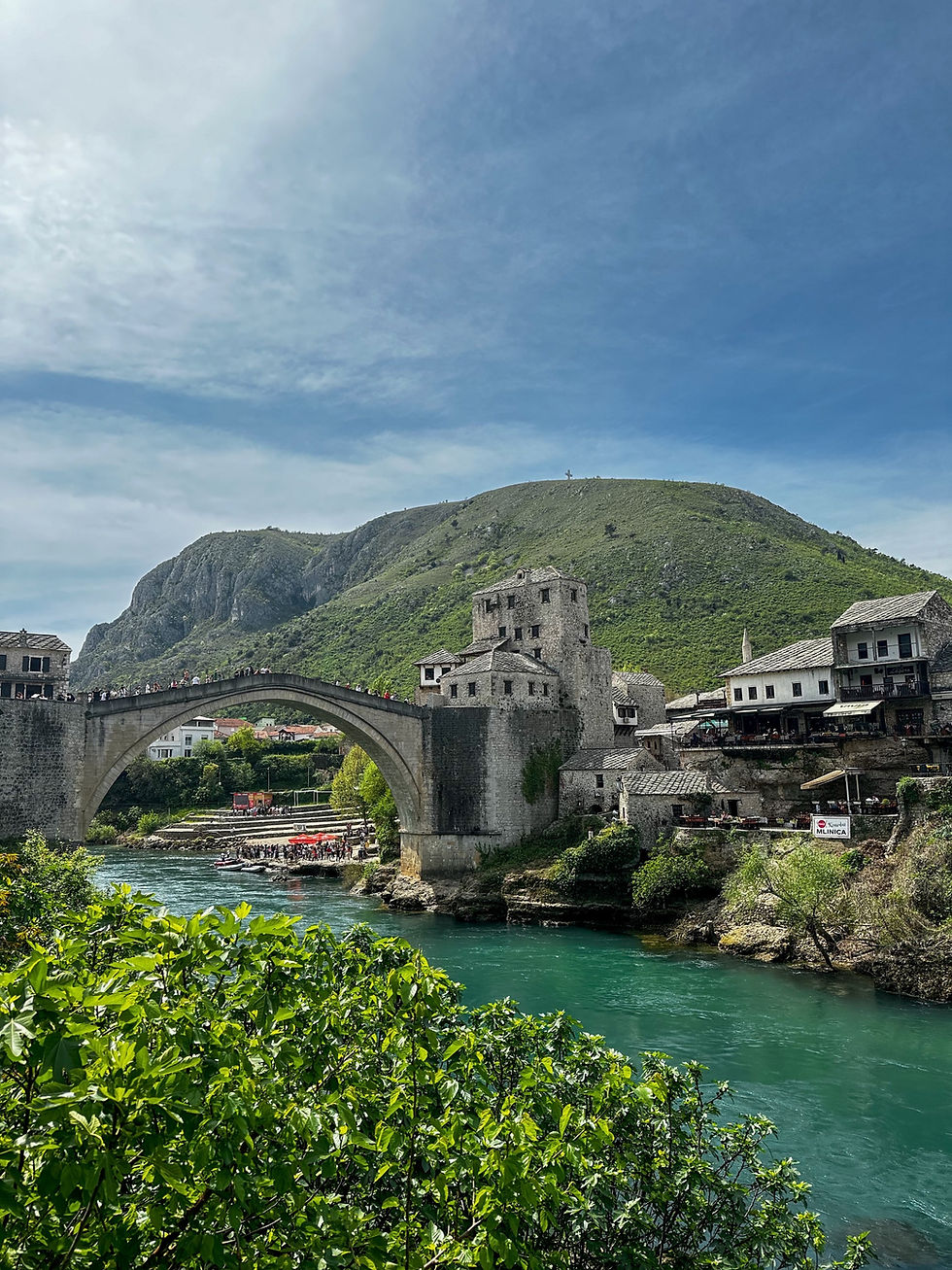
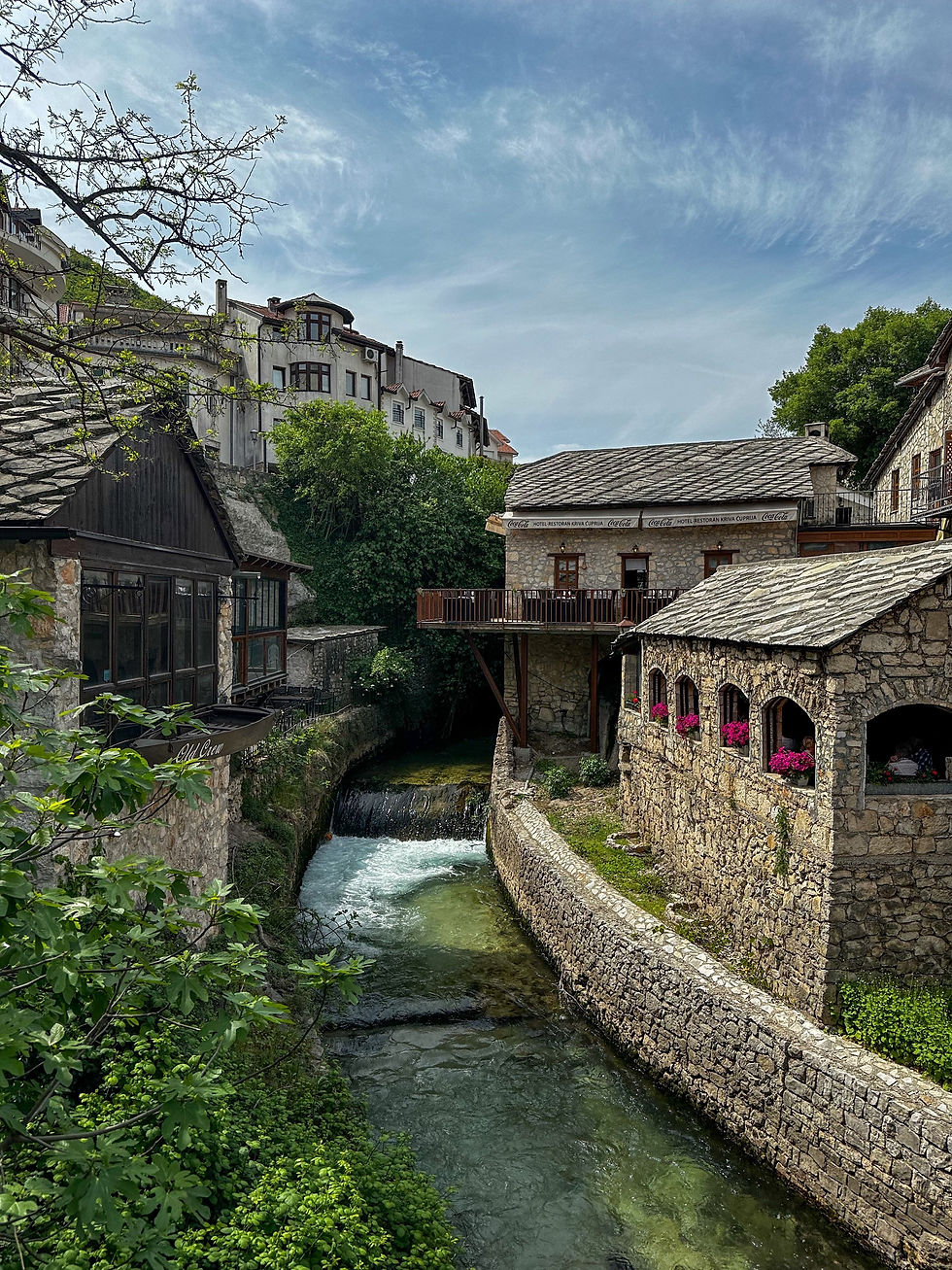
What Should We Eat?
If you have been to Bosnia, there are two products you absolutely must try: one is cevapi (meatballs) and the other is Bosnian pastry. You should not leave without eating these.
I will give you short and concise suggestions; for Bosnian pastry, ''SAC börekçisi'', for meatballs, Divan restaurant is recommended in many blogs, but we couldn't find a place there because we forgot to make a reservation. The place we tried was Ćevabdžinica Željo-2, we liked it very much, you can try this place as an alternative.
The most popular cevapi shop in Bascarsija is Zeljo, which was founded in 1968 and has three branches. It is named after one of the long-standing football teams in Bosnia, Zeljeznicar. The owners of the shop chose this name inspired by their devotion to their football team. Cevapi can be ordered in portions of 5, 10 and 15. We think the best one is Zeljo-2. You should also try eating it with kaymak (similar to our yogurt kaymak), which is also the Bosnian way of eating it, it is delicious.
Classic Bosnian pie is made with minced meat, when you order “börek” you will receive 1 portion of minced meat pie. You can also taste different types of pies such as potato, cheese, zucchini pie, in our opinion the best is still the classic Bosnian Pie.
You will see that the locals want their börek with sauce, and the sauce here is yogurt poured over the börek. The börek is served with yogurt and it is recommended to choose the classic Bosnian börek with yogurt. Order as “börek with minced meat sauce, and tea”. One börek is enough for two people, but you can try one with sauce and one without sauce. So when you say sauce here, you think of yogurt, and when you say clotted cream, you think of yogurt :)
Before you go for a Sarajevo food and drink guide, I recommend you to check out the 'Footsteps Delights' YouTube account.
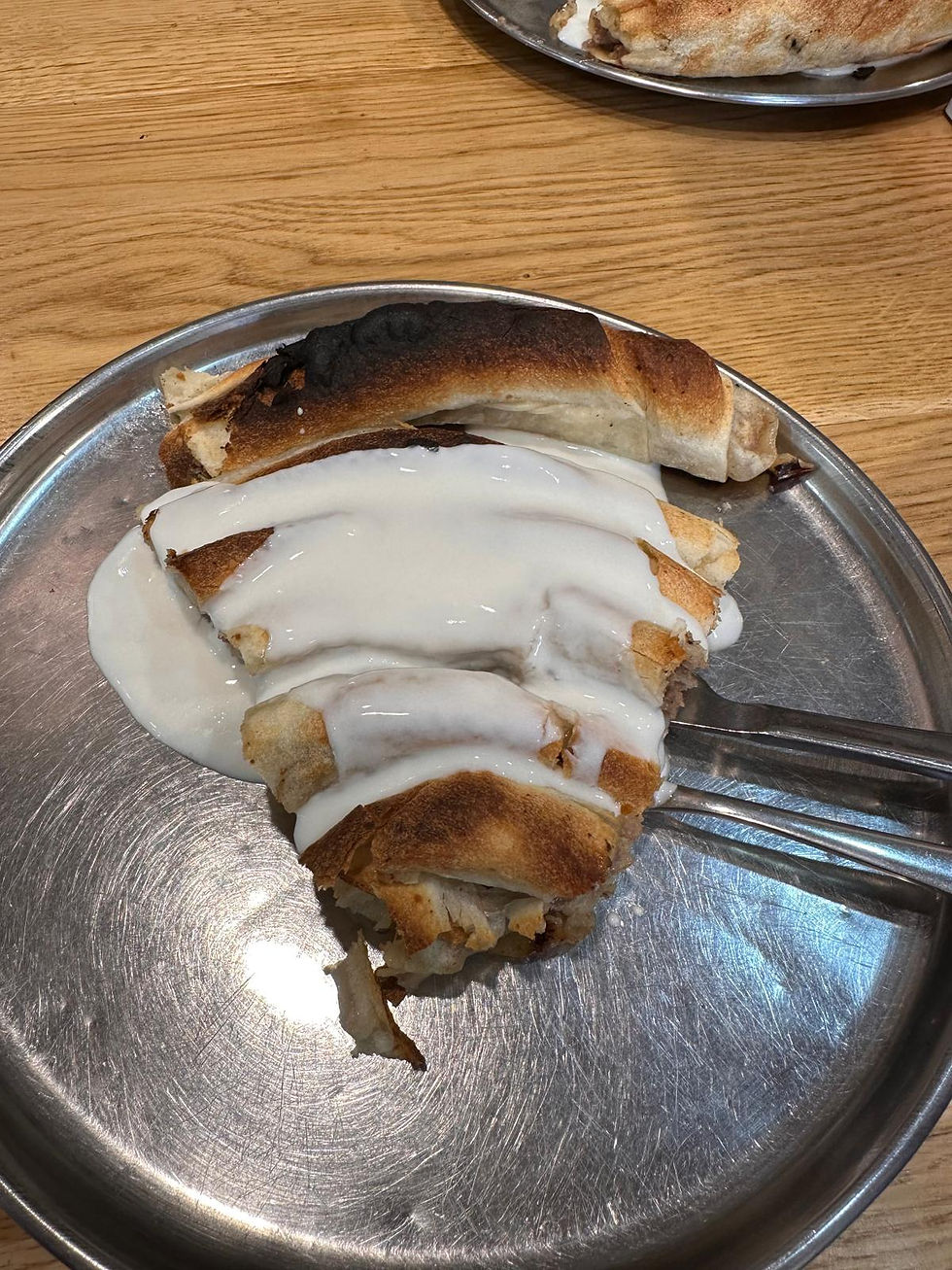
Bosnians continue to meticulously keep alive the coffee tradition they inherited from the Ottomans. Our cultures are so intertwined that Bosnian coffee is sometimes referred to as Turkish coffee and is slowly brewed in a copper cezve for each person. This coffee, which is usually served with Turkish delight, differs from Turkish coffee in that no sugar is added during brewing. Coffee, served in a copper tray, cezve and a thin cup without a handle, has an important place in Bosnian culture. You can find coffee sets produced with traditional copper workmanship in Bascarsija. You can buy these sets as gifts for your loved ones.
For coffee, I especially recommend 'CEJF COFFE' located in Bascarsija, which will also attract your attention with its interior decoration.
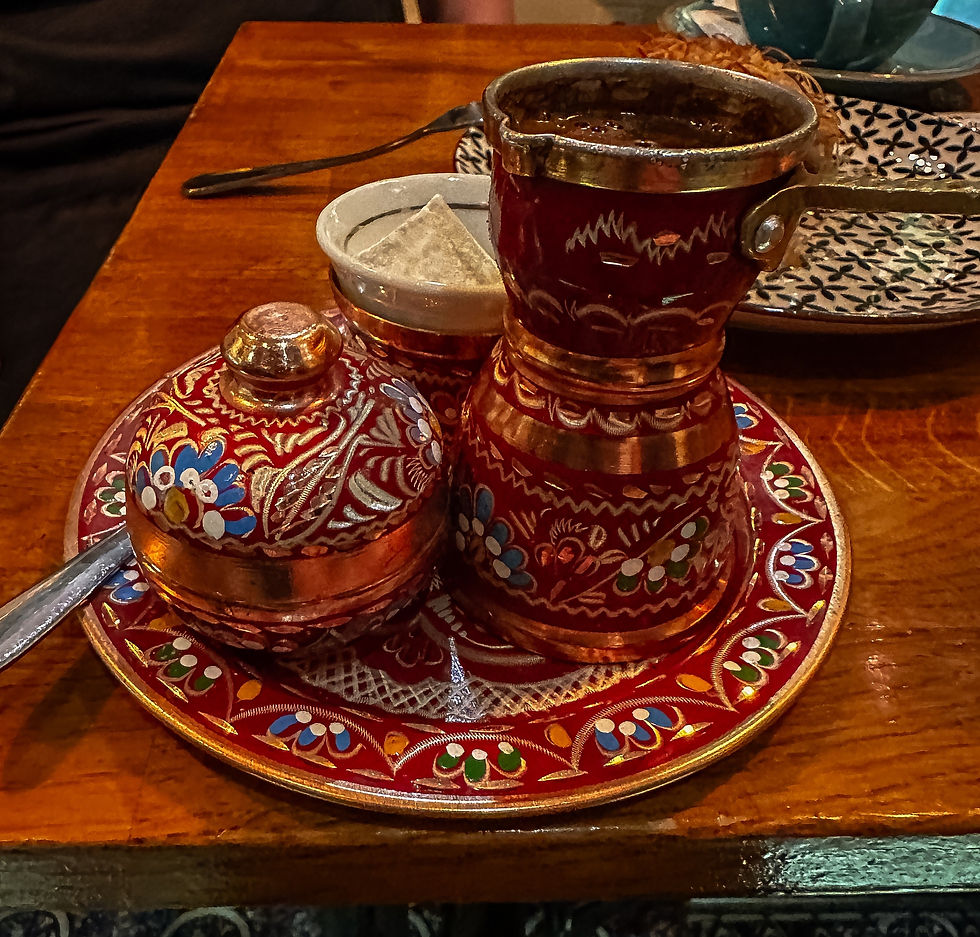
Where Should I Stay? - Bosnia- Sarajevo
For accommodation in Bosnia and Herzegovina, you can find hotels, hostels and boutique accommodation options in cities such as Sarajevo, Mostar, Banja Luka, and Tuzla.
The best place to stay in Sarajevo may be Bascarsija, as it is the city center and close to everywhere, you can research airbnb or hotel options here.
How to Get There? - Transportation
It is very easy to reach Bosnia and Herzegovina from both Turkey and different parts of Europe. There are direct flights from Turkey to Sarajevo, and it is also possible to reach it by plane or bus from many cities in Europe. Within the country, buses and trains are the most frequently used public transport. The developed bus network connects almost every city and town, while trains offer impressive views, especially on the Sarajevo-Mostar route.
Those traveling by train between Sarajevo and Mostar can benefit from two services, morning and evening. Trains depart from Sarajevo at 07:15 and 18:18, and from Mostar at 07:06 and 17:05. During this journey, which takes approximately 2.5 hours, you can enjoy the impressive views of the Neretva River and the surrounding green mountains. During the journey, it is recommended that you sit on the left side when going and on the right side when returning, in terms of the view. Train tickets can only be purchased at the stations, and there are no online reservation or purchase options. When you arrive at Mostar Train Station, turn left as soon as you leave the station and walk parallel to the river, and you can reach the Mostar Bridge in approximately 15 minutes.
Bus transportation is also very popular and there are frequent trips between many cities. In addition, the scenic roads throughout the country make bus trips an enjoyable experience. Transportation by taxi is relatively affordable, especially in big cities, walking and renting a bike can be your alternative options. Bosnia-Herzegovina offers the opportunity to easily explore both big cities and natural beauties thanks to its variety of transportation.
If you have a rental car or your own vehicle, you can travel around the city without any problems, especially when visiting central points such as Bascarsija, we can also suggest a parking lot for you to park your car; There is a huge parking lot like our Ispark right across from the Vijecnica Municipality Building, which is also known as the National Library - Municipality Building, you can leave your car there and explore the city comfortably.
When to Go?
The best times to visit Bosnia and Herzegovina are spring (April-May) and autumn (September-October). During these periods, the weather conditions are more suitable and the tourist density is less. Due to the visa-free and convenient location, you may encounter a serious tourist density during our official holidays. If you are planning a quieter trip, prefer to come outside of official holidays if possible.
Suggestions
Make sure you make a reservation for the restaurant you will go to for dinner in advance, as it is not possible to find a seat later. (Especially for Divan restaurant)
We recommend that you make your bus and train reservations in advance for intercity travel. The Mostar-Sarajevo train journey is becoming more popular.
Make sure to carry cash KM in your pocket. They do not accept euros like other Balkan countries.
By making a reservation at https://www.sarajevowalkingtours.com/, you can tour the center of Sarajevo with “Free Walking Tours Sarajevo” and get an idea about its history and culture accompanied by a local.
This guide contains useful information for those considering visiting Bosnia and Herzegovina.






Comments